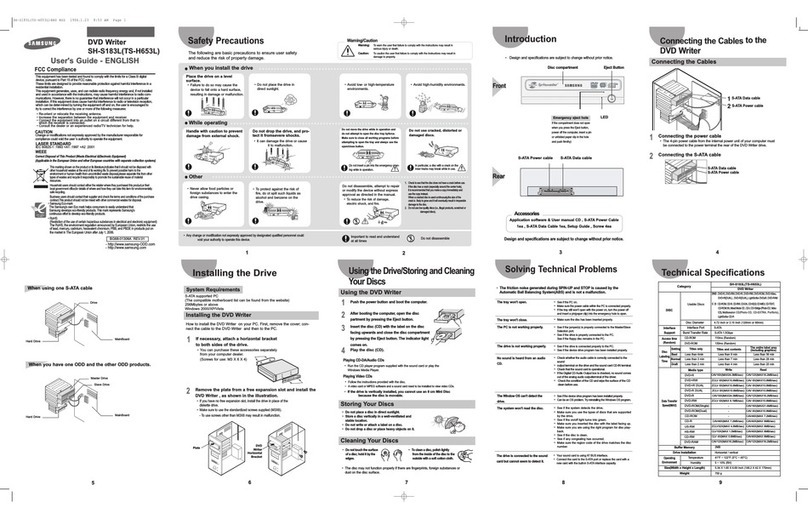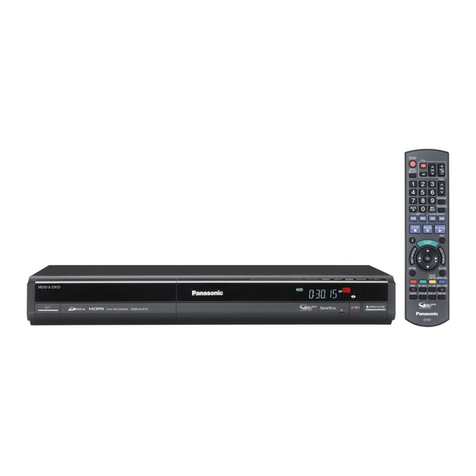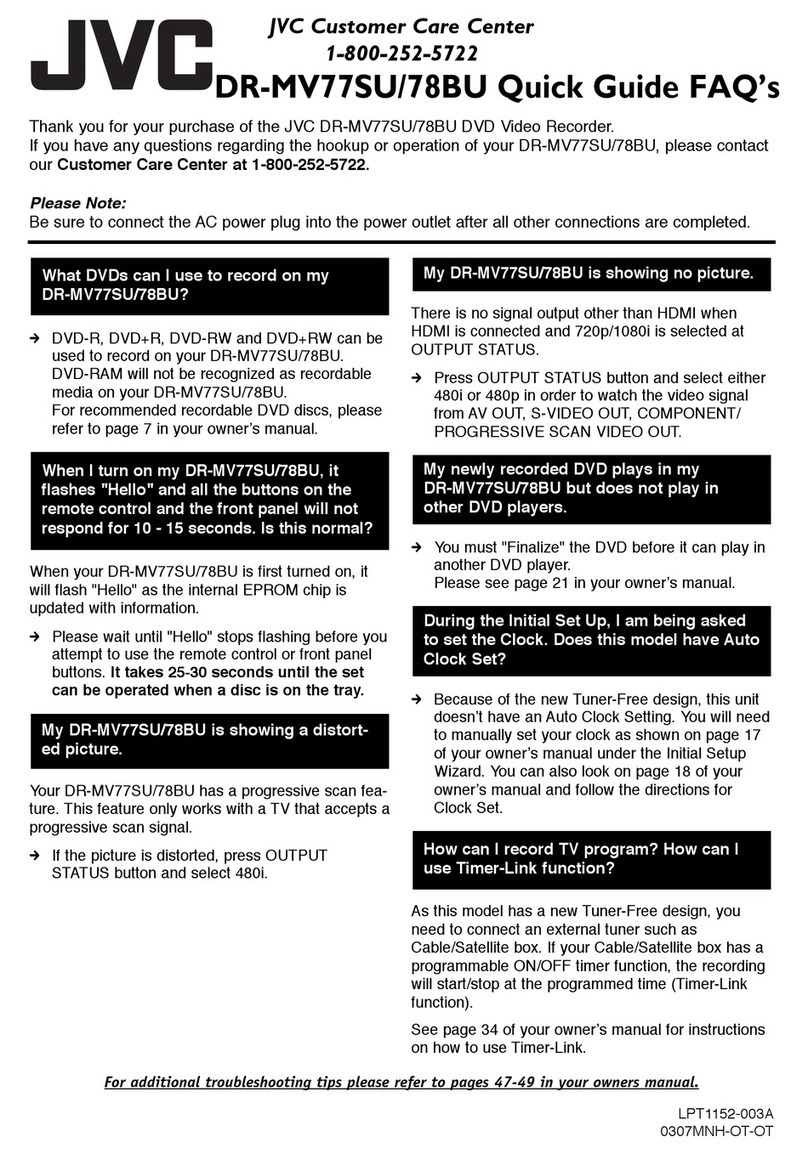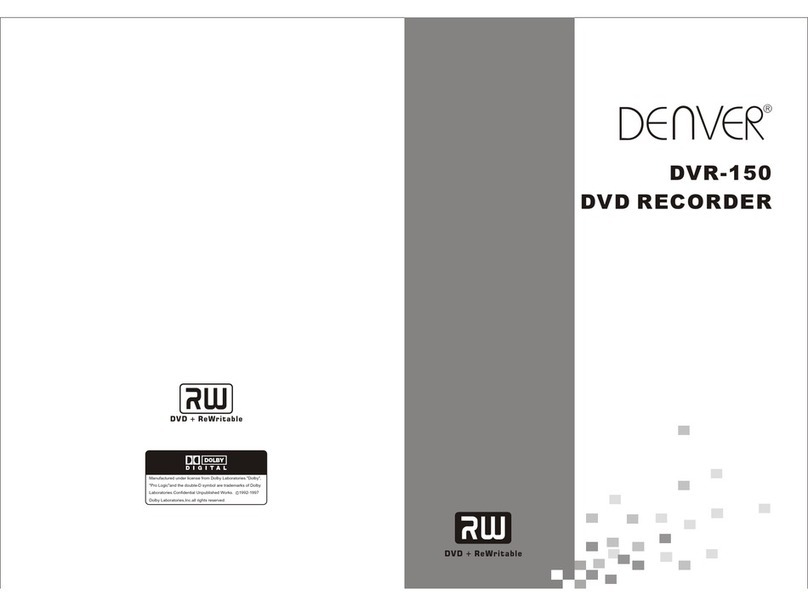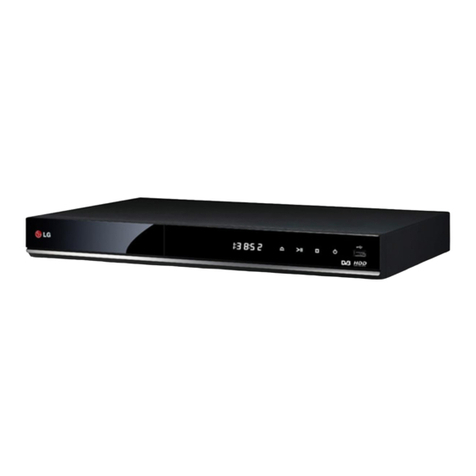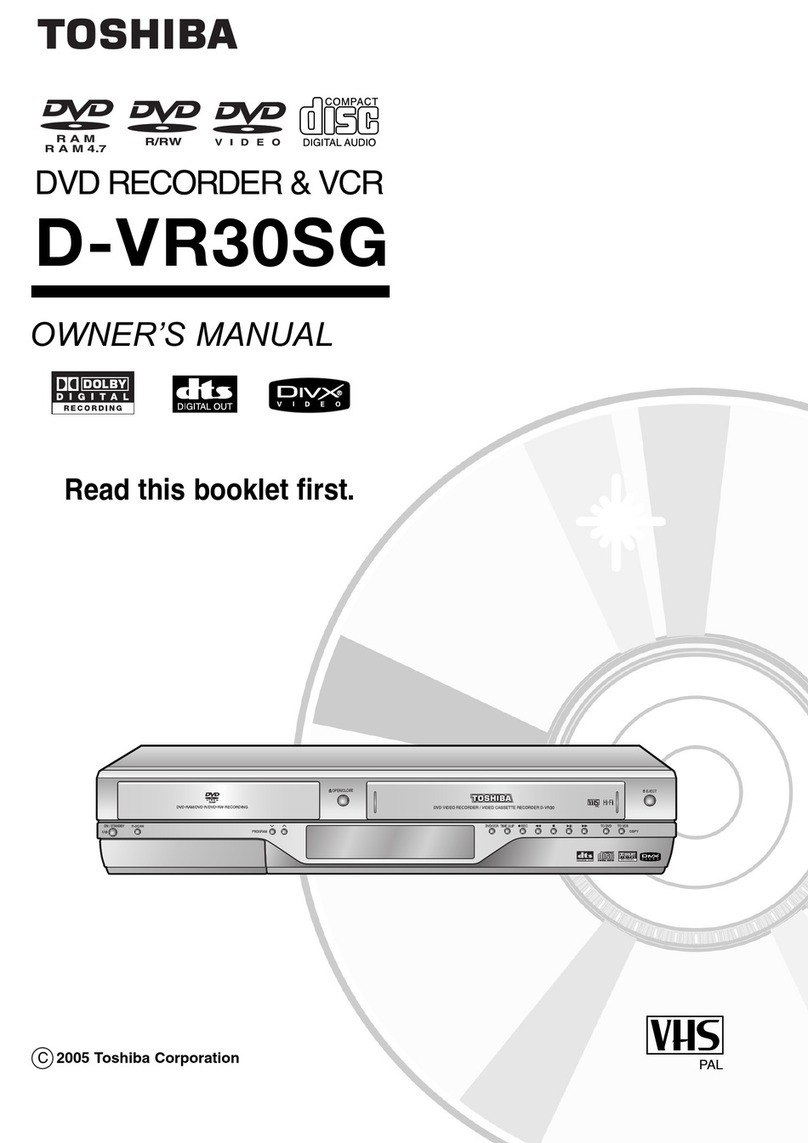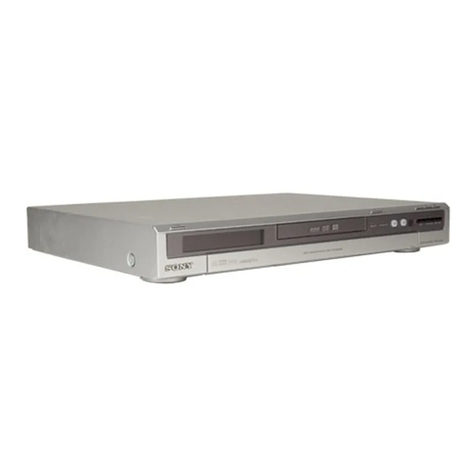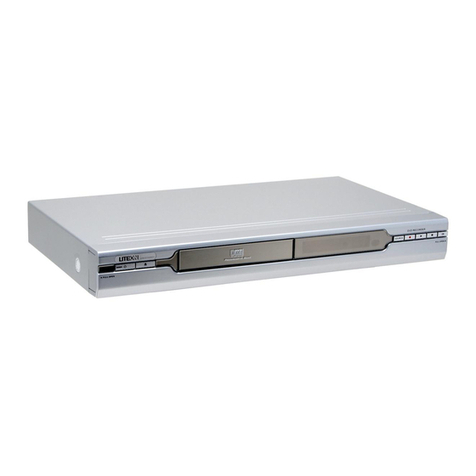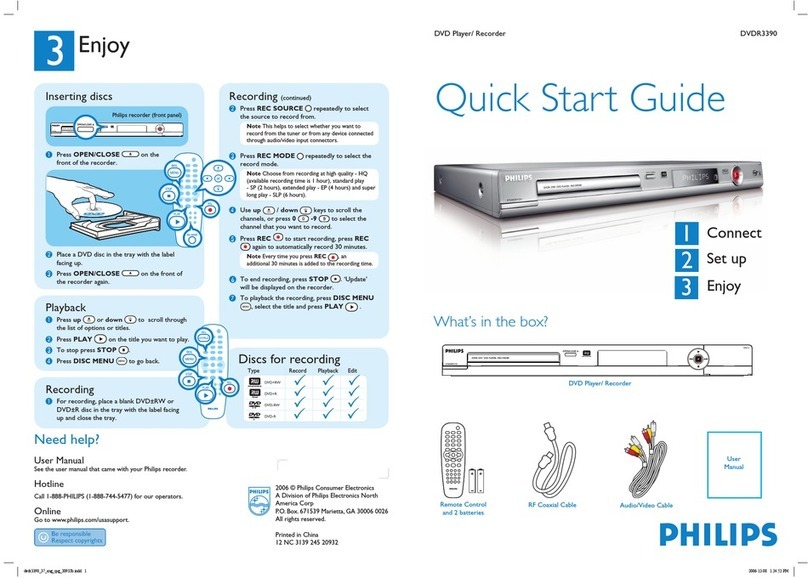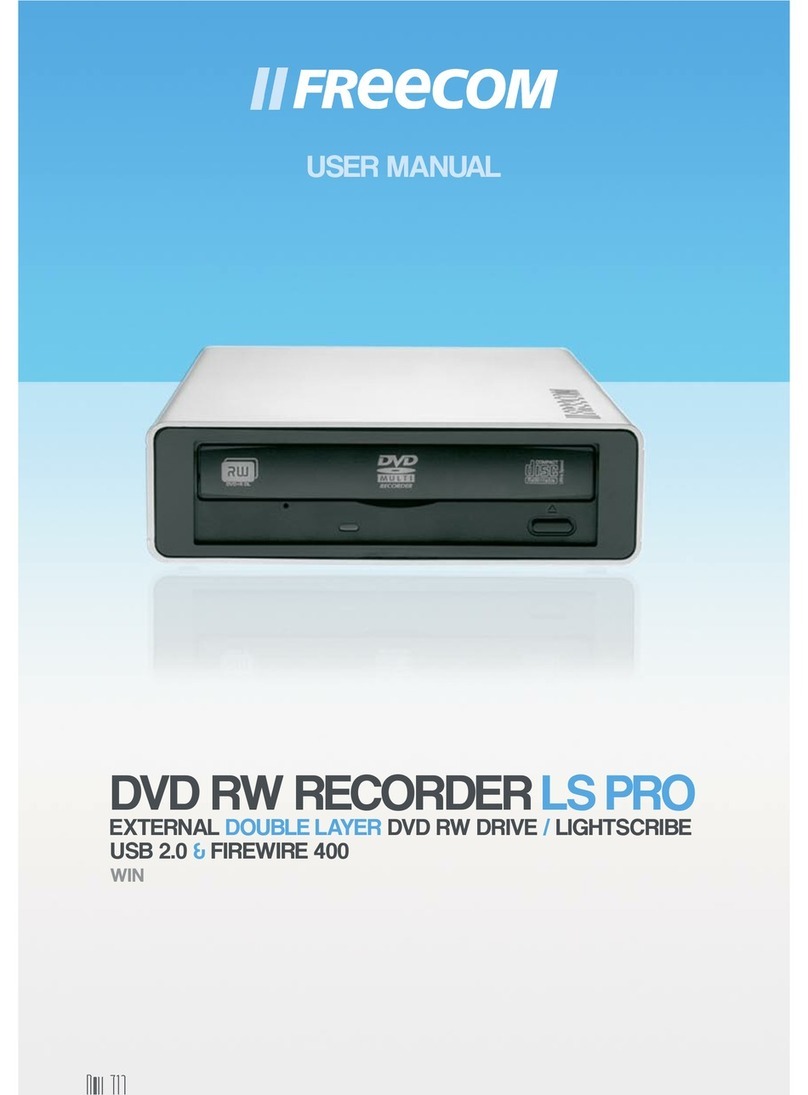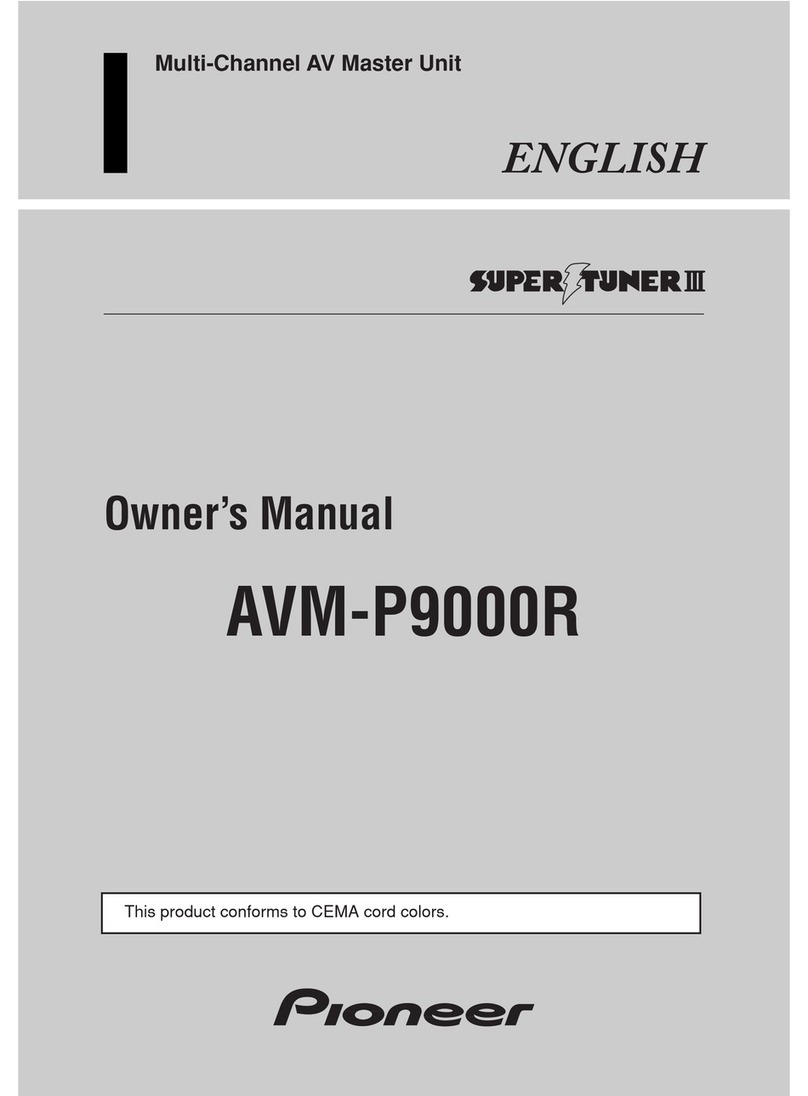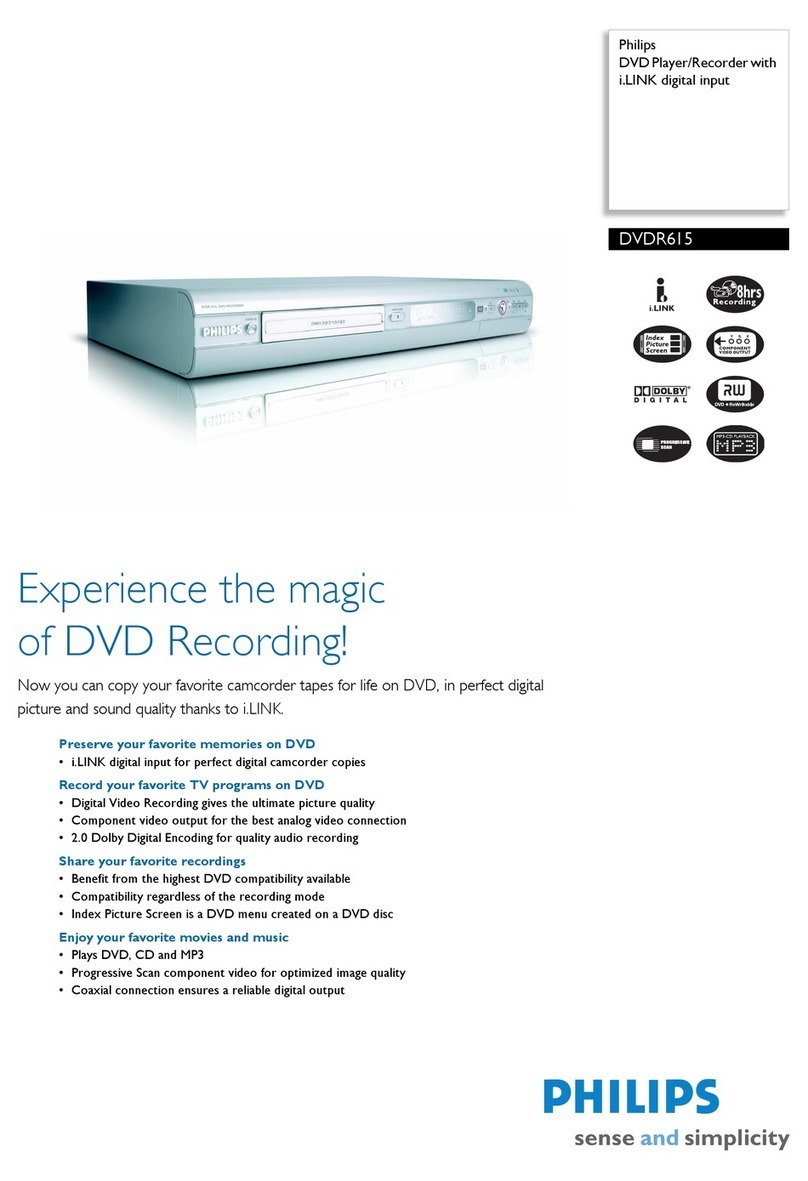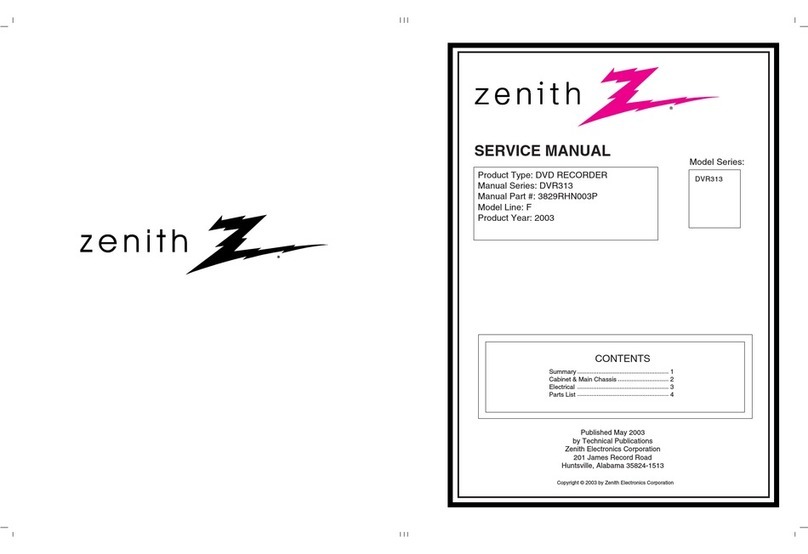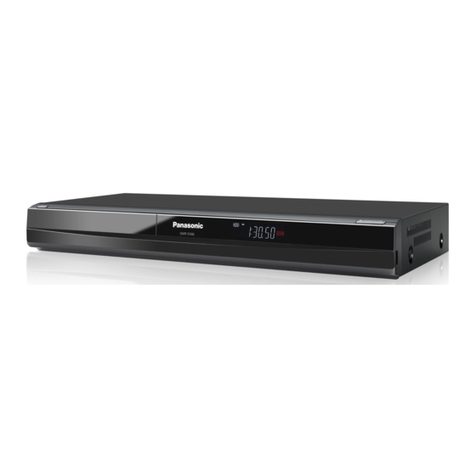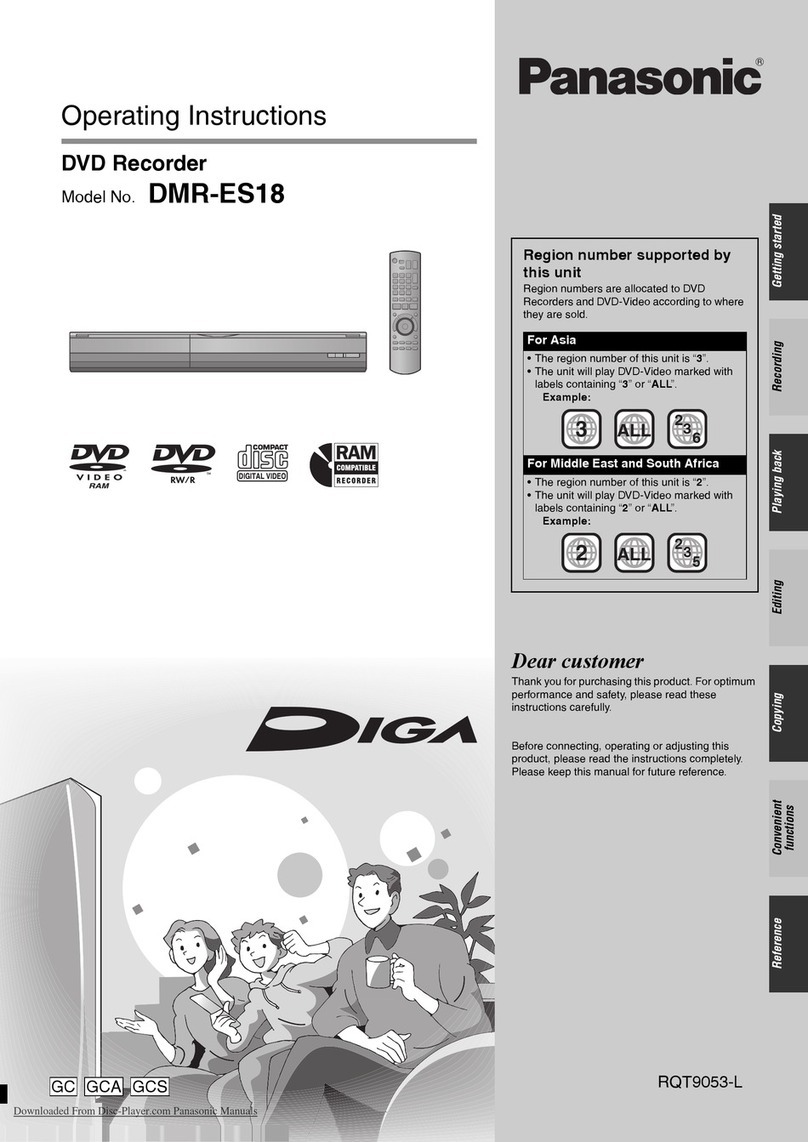Allegro ABR521 User manual

MODEL : ABR521
SERVICE MANUAL
P/NO : 3829RGN004P APRIL, 2005
MODEL : ABR521
VCR+DVD RECORDER

1-1
SECTION 1
SUMMARY
CONTENTS
PRODUCT SAFETY SERVICING GUIDELINES FOR VIDEO PRODUCTS ............. 1-2
SERVICING PRECAUTIONS .................................................................................................. 1-3
THE STEPS FOR CHANGE THE OPTION CODE ........................................................... 1-4
UP-DATING PROGRAM ........................................................................................................... 1-5
SPECIFICATIONS ...................................................................................................................... 1-7

1-2
IMPORTANT SAFETY NOTICE
This manual was prepared for use only by properly trained audio-video service
technicians.
When servicing this product, under no circumstances should the original
design be modified or altered without permission from ALLEG O Electronics
Corporation. All components should be replaced only with types identical to
those in the original circuit and their physical location, wiring and lead dress
must conform to original layout upon completion of repairs.
Special components are also used to prevent x-radiation, shock and fire haz-
ard. These components are indicated by the letter “x” included in their compo-
nent designators and are required to maintain safe performance. No deviations
are allowed without prior approval by ALLEG O Electronics Corporation.
Circuit diagrams may occasionally differ from the actual circuit used. This way,
implementation of the latest safety and performance improvement changes
into the set is not delayed until the new service literature is printed.
CAUTION: Do not attempt to modify this product in any way. Never perform
customized installations without manufacturer’s approval. Unauthorized modi-
fications will not only void the warranty, but may lead to property damage or
user injury.
Service work should be performed only after you are thoroughly familiar with
these safety checks and servicing guidelines.
GRAPHIC SYMBOLS
The exclamation point within an equilateral triangle is intended to
alert the service personnel to important safety information in the
service literature.
The lightning flash with arrowhead symbol within an equilateral tri-
angle is intended to alert the service personnel to the presence of
noninsulated “dangerous voltage” that may be of sufficient magni-
tude to constitute a risk of electric shock.
The pictorial representation of a fuse and its rating within an equi-
lateral triangle is intended to convey to the service personnel the
following fuse replacement caution notice:
CAUTION: FO CONTINUED P OTECTION AGAINST ISK
OF FI E, EPLACE ALL FUSES WITH THE SAME TYPE AND
ATING AS MA KED NEA EACH FUSE.
SERVICE INFORMATION
While servicing, use an isolation transformer for protection from AC line shock.
After the original service problem has been corrected, make a check of the fol-
lowing:
FIRE AND SHOCK HA ARD
1. Be sure that all components are positioned to avoid a possibility of adjacent
component shorts. This is especially important on items trans-ported to and
from the repair shop.
2. Verify that all protective devices such as insulators, barriers, covers, shields,
strain reliefs, power supply cords, and other hardware have been reinstalled
per the original design. Be sure that the safety purpose of the polarized line
plug has not been defeated.
3. Soldering must be inspected to discover possible cold solder joints, solder
splashes, or sharp solder points. Be certain to remove all loose foreign par-
ticles.
4. Check for physical evidence of damage or deterioration to parts and compo-
nents, for frayed leads or damaged insulation (including the AC cord), and
replace if necessary.
5. No lead or component should touch a high current device or a resistor rated
at 1 watt or more. Lead tension around protruding metal surfaces must be
avoided.
6. After reassembly of the set, always perform an AC leakage test on all
exposed metallic parts of the cabinet (the channel selector knobs, antenna
terminals, handle and screws) to be sure that set is safe to operate without
danger of electrical shock. DO NOT USE A LINE ISOLATION T ANS-
FO ME DU ING THIS TEST. Use an AC voltmeter having 5000 ohms per
volt or more sensitivity in the following manner: Connect a 1500 ohm, 10
watt resistor, paralleled by a .15 mfd 150V AC type capacitor between a
known good earth ground water pipe, conduit, etc.) and the exposed metal-
lic parts, one at a time. Measure the AC voltage across the combination of
1500 ohm resistor and .15 mfd capacitor. everse the AC plug by using a
non-polarized adaptor and repeat AC voltage measurements for each
exposed metallic part. Voltage measured must not exceed 0.75 volts MS.
This corresponds to 0.5 milliamp AC. Any value exceeding this limit consti-
tutes a potential shock hazard and must be corrected immediately.
TIPS ON PROPER INSTALLATION
1. Never install any receiver in a closed-in recess, cubbyhole, or closely fitting
shelf space over, or close to, a heat duct, or in the path of heated air flow.
2. Avoid conditions of high humidity such as: outdoor patio installations where
dew is a factor, near steam radiators where steam leakage is a factor, etc.
3. Avoid placement where draperies may obstruct venting. The customer
should also avoid the use of decorative scarves or other coverings that
might obstruct ventilation.
4. Wall- and shelf-mounted installations using a commercial mounting kit must
follow the factory-approved mounting instructions. A product mounted to a
shelf or platform must retain its original feet (or the equivalent thickness in
spacers) to provide adequate air flow across the bottom. Bolts or screws
used for fasteners must not touch any parts or wiring. Perform leakage tests
on customized installations.
5. Caution customers against mounting a product on a sloping shelf or in a tilt-
ed position, unless the receiver is properly secured.
6. A product on a roll-about cart should be stable in its mounting to the cart.
Caution the customer on the hazards of trying to roll a cart with small cast-
ers across thresholds or deep pile carpets.
7. Caution customers against using extension cords. Explain that a forest of
extensions, sprouting from a single outlet, can lead to disastrous conse-
quences to home and family.
A.C. Voltmeter
1500 OHM
10 WATT
Place this probe
on each exposed
metal part.
Good Earth Ground
such as the Water
Pipe, Conduit, etc.
0.15uF
PRODUCT SAFETY SERVICING GUIDELINES FOR VIDEO PRODUCTS

1-3
SERVICING PRECAUTIONS
CAUTION: Before servicing the VC + DVD ECODE cov-
ered by this service data and its supplements and addends,
read and follow the SAFETY PRECAUTIONS. NOTE: if
unforeseen circumstances create conflict between the fol-
lowing servicing precautions and any of the safety precau-
tions in this publications, always follow the safety precau-
tions.
Remember Safety First:
General Servicing Precautions
1. Always unplug the VC + DVD ECODE AC power cord
from the AC power source before:
(1) emoving or reinstalling any component, circuit board,
module, or any other assembly.
(2) Disconnecting or reconnecting any internal electrical
plug or other electrical connection.
(3) Connecting a test substitute in parallel with an elec-
trolytic capacitor.
Caution: A wrong part substitution or incorrect
polarity installation of electrolytic capacitors may result
in an explosion hazard.
2. Do not spray chemicals on or near this VC + DVD
ECODE or any of its assemblies.
3. Unless specified otherwise in this service data, clean
electrical contacts by applying an appropriate contact
cleaning solution to the contacts with a pipe cleaner,
cotton-tipped swab, or comparable soft applicator.
Unless specified otherwise in this service data, lubrication
of contacts is not required.
4. Do not defeat any plug/socket B+ voltage interlocks with
whitch instruments covered by this service manual might
be equipped.
5. Do not apply AC power to this VC + DVD ECODE
and / or any of its electrical assemblies unless all solid-
state device heat sinks are correctly installed.
6. Always connect the test instrument ground lead to an
appropriate ground before connecting the test instrument
positive lead. Always remove the test instrument ground
lead last.
Insulation Checking Procedure
Disconnect the attachment plug from the AC outlet and turn
the power on. Connect an insulation resistance meter (500V)
to the blades of the attachment plug. The insulation resis-
tance between each blade of the attachment plug and acces-
sible conductive parts (Note 1) should be more than 1M-
ohm.
Note 1: Accessible Conductive Parts include Metal panels,
Input terminals, Earphone jacks,etc.
Electrostatically Sensitive (ES) Devices
Some semiconductor (solid state) devices can be damaged
easily by static electricity. Such components commonly are
called Electrostatically Sensitive (ES) Devices. Examples of
typical ES devices are integrated circuits and some field
effect transistors and semiconductor chip components.
The following techniques should be used to help reduce the
incidence of component damage caused by static electricity.
1. Immediately before handling any semiconductor compo-
nent or semiconductor-equipped assembly, drain off any
electrostatic charge on your body by touching a known
earth ground. Alternatively, obtain and wear a commer-
cially available discharging wrist strap device, which
should be removed for potential shock reasons prior to
applying power to the unit under test.
2. After removing an electrical assembly equipped with ES
devices, place the assembly on a conductive surface such
as aluminum foil, to prevent electrostatic charge buildup or
exposure of the assembly.
3. Use only a grounded-tip soldering iron to solder or unsolder
ES devices.
4. Use only an anti-static solder removal device. Some
solder removal devices not classified as “anti-static” can
generate electrical charges sufficient to damage ES
devices.
5. Do not use freon-propelled chemicals. These can
generate an electrical charge sufficient to damage ES
devices.
6. Do not remove a replacement ES device from its protec-
tive package until immediately before you are ready to
install it. (Most replacement ES devices are packaged with
leads electrically shorted together by conductive foam,
aluminum foil,or comparable conductive material).
7. Immediately before removing the protective material from
the leads of a replacement ES device, touch the protective
material to the chassis or circuit assembly into which the
device will be installed.
Caution: Be sure no power is applied to the chassis or
circuit, and observe all other safety precautions.
8. Minimize bodily motions when handling unpackaged
replacement ES devices. (Normally harmless motion such
as the brushing together of your clothes fabric or the lifting
of your foot from a carpeted floor can generate static elec-
tricity sufficient to damage an ES device.)

1-4
THE STEPS FOR CHANGE THE OPTION CODE
Push Switch POWE ON/ OFF
at remocon or timer keyborad
Select DVD MODE at the set
use remocon or timer keyborad
Push EC+ PLAY
at timer keyboard
Use remocon and push ENTE
Use Direction Key at
remocon (LEFT/ IGHT)
for select the position of option
Use Direction Key
at remocon (UP/ DOWN)
for change the option
After finish edit code of option
push ENTE at remocon
For finishing and intialized
the option code push
EC + EJECT at remocon
Note : This procedure must be done when IC304(On digital Board) or Digital Boardassy
ABR521
NAME HEX
OPT1 F2
OPT2 55
OPT3 53
OPT4 55
OPT5 17
OPT6 B8
OPT7 20
OPT8 00
Press “Enter” key
to Save and Exit
DETECT NEW EEP OM (OPTION EDIT SC EEN)

BURNING DISC
• For up-dating the DVD program using the disc, it must burning the disc which include the DVD software.
• For recorder combi set which using the disc downloader program are DVD Program and Loader Program.
• In 2nd generation for recorder combi can download the DVD program and Loader program one by one, or all
together.
• If you format like number 1 you’ll see capture like (figure 1)
• And you have three choice:
1. Main. It’s mean if you chose this it’ll up-dating only DVD prgram.
2. Loader.It’s mean if you chose this it’ll up-dating only Loader program.
3. ALL. It’s mean if you chose this it’ll up-dating DVD and Loader program.
• If you format like number 2 you’ll not see capture like figure 1 that give you choices, you have no choice only
update DVD program
1-5
UP-DATING PROGRAM
* There is two way to format disc DVD Program
1. DVD and LOADE program format in one
disc
2. Only DVD program format in one disc
(Figure 1)
Number 1
Number 2

1-6
DVD UPGRADE INSTRUCTION
FORMAT NO 1
1. Press POWE KEY to turn on.
2. After booting, insert the upgrade disc, and you will see massage like [FIGU E 1]
3. Press “ EC” key (front or remote) 3 times and you will see as [FIGU E 2] with remote Chose one of them
then Press enter
4. For update both of them [MAIN & LOADE ] we chose “ALL” and first you will see [FIGU E 3] DVD update
→Check the “Current Version” and “ New CD Write Version” and press “ EC” key.
5. The DVD update will be on progress.And when finish update MAIN Version it’s automatically continue to
Update Loader Version and You will see [FIGU E 4]
→Check the “Current Version” and “New CD Write Version “ and Press “ EC” key once more
6. The LOADE update will be on progress. And tray will open.
7. emove the disc and wait until finish
8. The tray will be close and open automatically after completing “UNDE UPDATE” 100%
9. Turn off the unit
10. Turn on again the unit is operation with new software
FORMAT NO 2
1. Press POWE KEY to turn on.
2. After booting, insert the upgrade disc, and you will see massage like [FIGU E 1]
3. Press “ EC” key (front or remote) 3 times
4. The DVD update will be on progress.
→Check the “Current Version” and “New CD Write Version “ and Press “ EC” key once more
5. The tray will be open automatically after completing “UNDE UPDATE” 100%
6. emove the disc andTurn off the unit
7. Turn on again the unit is operation with new software
[FIGURE 1] [FIGURE 2] [FIGURE 3] [FIGURE 4]
[FIGURE 1] [FIGURE 2]

1-7
SPECIFICATIONS
General
Power requirements AC 120V, 60 Hz
Power consumption 35W
Dimensions (approx.) 430 X 78.5 X 354 mm (w x h x d)
Mass (approx.) 5.7 kg
Operating temperature 5°C to 35°C
Operating humidity 5 % to 90 %
Television system NTSC color system
ecording format NTSC
System
Laser Semiconductor laser, wavelength 650 mm
Video head system Double azimuth 4 heads, helical scanning
Signal system NTSC
Recording
ecording format DVD+ W/+ Video format
ecordable discs DVD- eWritable, DVD- ecordable, DVD+ eWritable, DVD+ ecordable
ecordable time Approx. 1 hour (XP mode), 2 hours (SP mode), 4 hours (LP mode),
6 hours (EP mode)
Video recording format
Sampling frequency 27MHz
Compression format MPEG 2
Audio recording format
Sampling frequency 48kHz
Compression format Dolby Digital
Playback
Frequency response DVD (PCM 48 kHz): 8 Hz to 22 kHz, CD: 8 Hz to 20 kHz
DVD (PCM 96 kHz): 8 Hz to 44 kHz
Harmonic distortion Less than 0.008% (AUDIO OUT connector)
Dynamic range More than 95 dB (AUDIO OUT connector)
Inputs
F IN F input, 75 ohms
VIDEO IN 1.0 Vp-p 75 ohms, sync negative, CA jack
AUDIO IN 0 dBm more than 47 kohms, CA jack (L, )
DV IN 4 pin (i.LINK/IEEE 1394 standard)
S-VIDEO IN (Y) 1.0 V (p-p), 75 Ω, negative sync, Mini DIN 4-pin x 1
(C) 0.3 V (p-p) 75 Ω
Outputs
S-VIDEO OUT (Y) 1.0 V (p-p), 75 Ω, negative sync, Mini DIN 4-pin x 1
(C) 0.3 V (p-p) 75 Ω
COMPONENT VIDEO OUT (Y) 1.0 V (p-p), 75 Ω, negative sync, CA jack x 1
(Pb)/(Pr) 0.7 V (p-p), 75 Ω, CA jack x 2
Audio output (digital audio) 0.5 V (p-p), 75 Ω, CA jack x 1
Audio output (analog audio) 2.0 Vrms (1 KHz, 0 dB), 600 Ω, CA jack (L, ) x 1
* Design and specifications are subject to change without notice.
* Manufactured under license from Dolby Laboratories. “Dolby”, “Pro Logic” and the double-D symbol are trademarks of
Dolby Laboratories.
* DTS and DTS Digital Out are registered trademarks of Digital Theater Systems, Inc.

2-1
SECTION 2
EXPLODED VIEWS
CONTENTS
EXPLODED VIEWS .....................................................................................................................2-2
1. Cabinet and Main Frame Section ...........................................................................................2-2
2. Deck Mechanism Section (RL-05) ..........................................................................................2-3
3. Packing Accessory Section ....................................................................................................2-4

2-2
EXPLODED VIEWS
1. Cabinet and Main Frame Section
283
28
284
469
286
457
A43
285
A48
274
261
452
261
261
266
263
264
468
265
465
32
26
A44
3
A
457
47
257
256
255
469
463
25
463
463
469
A52
A6
457
278
457
A5
A47
A54
276
469
323
321
469
A46

2-3
2. Deck Mechanism Section (RL-05)
1001
A001
A60
1434 1434 1025
1025
1030
1432
1038 1029
1432
1021 1432
1432
1032
1033
1011
1019
1020
1019
1009
1012
1013
1435
1014
1016
1015
1017
1018 1018A
1018B
1018C
1018E 1018D
1006
1436
10241433
1029
1027
1027
1005
1026
1003 1002
A004
A002
1041
1042
1434
1434
A000
1437

2-4
3. Packing Accessory Section
BATTERY
808
BAG
804
PACKING
803
806
INSTRUCTION ASSEMBLY
CABLE(COAXIAL)
810 CABLE ASS'Y RF
801
REMOCON
900
FILTER
826
BOX CARTON
802
PACKING
803
811
812
PLUG ASS'Y 1WAY
PLUG ASS'Y 2WAY
OPTIONAL PARTS

3-1
SECTION 3
ELECTRICAL
CONTENTS
OVERALL WIRING DIAGRAM..............................3-2
VCR PART
ELECTRICAL ADJUSTMENT
PROCEDURES............................................................3-3
VCR ELECTRICAL TROUBLESHOOTING
GUIDE.............................................................................3-4
1. POWE (SMPS) CI CUIT .......................................3-4
2. SYSTEM/KEY CI CUIT ..........................................3-7
3. SE VO CI CUIT.....................................................3-8
4. Y/C CI CUIT..........................................................3-11
5. HI-FI CI CUIT .......................................................3-15
6. TUNE /IF CI CUIT...............................................3-18
BLOCK DIAGRAMS................................................3-20
1. POWE (SMPS) BLOCK DIAG AM......................3-20
2. AVCP BLOCK DIAG AM ......................................3-22
3. SYSTEM BLOCK DIAG AM.................................3-24
4. JACK BLOCK DIAG AM ......................................3-26
5. STUNE /MTZ BLOCK DIAG AM.........................3-28
6. AVCP BLOCK DIAG AM ......................................3-30
CIRCUIT DIAGRAMS..............................................3-32
1. POWE (SMPS) CI CUIT DIAG AM ...................3-32
2. TU/IF CI CUIT DIAG AM ....................................3-34
3. A/V CI CUIT DIAG AM........................................3-36
4. HI-FI CI CUIT DIAG AM .....................................3-38
5. SYSTEM CI CUIT DIAG AM...............................3-40
6. JACK CI CUIT DIAG AM ....................................3-42
7. TIME CI CUIT DIAG AM( 2 TOOL ) .................3-44
8. TIME CI CUIT DIAG AM( 3 TOOL, 8 TOOL ) ..3-46
9. TIME CI CUIT DIAG AM( 4 TOOL ) .................3-48
10. TIME CI CUIT DIAG AM( 6 TOOL ) ...............3-50
11. TIME CI CUIT DIAG AM( 7 TOOL ) ...............5-52
• WAVEFO MS .........................................................3-54
• CI CUIT VOLTAGE CHA T ...................................3-56
PRINTED CIRCUIT DIAGRAMS.........................3-58
1. VC P.C.BOA D...................................................3-58
2. SMPS P.C.BOA D ...............................................3-60
3. JACK P.C.BOA D ................................................3-62
4. KEY P.C.BOA D .................................................3-64
5. TIME P.C.BOA D .............................................3-64
VDR PART
VDR ELECTRICAL TROUBLESHOOTING
GUIDE...........................................................................3-66
1. POWE (SMPS) CI CUIT .....................................3-66
2. NO COMPONENT VIDEO SIGNAL WHEN
PLAYING DISC......................................................3-68
3. NO COMPOSITE / S-VIDEO SIGNAL WHEN
PLAYING DISC......................................................3-69
4. NO TV, EXTE NAL INPUT VIDEO SIGNAL.........3-70
5. WHEN PLAYING DISC, NO AUDIO OUTPUT ......3-71
6. NO TUNE AUDIO OUTPUT ................................3-71
7. NO OPTICAL / DIGITAL OUTPUT ........................3-71
8. NO EXTE NAL INPUT 1, 2 AUDIO ......................3-72
9. NO EXTE NAL INPUT 3 AUDIO ..........................3-72
BLOCK DIAGRAMS................................................3-73
1. VD SET TOTAL BLOCK DIAG AM....................3-73
2. VD MAIN H/ W BLOCK DIAG AM.....................3-74
3. POWE BLOCK DIAG AM ..................................3-75
4. AUDIO IN/ OUT BLOCK DIAG AM ......................3-76
5. CPU & CONT OL EGISTE
BLOCK DIAG AM.................................................3-77
6. VIDEO IN/ OUT BLOCK DIAG AM ......................3-78
7. DV 1394 IN/OUT BLOCK DIAG AM ....................3-79
8. MEMO Y CA D IN/ OUT BLOCK DIAG AM ......3-80
CIRCUIT DIAGRAMS..............................................3-81
1. BGA 308P CI CUIT DIAG AM.............................3-81
2. DD & B TO B CONNECTO
CI CUIT DIAG AM ..............................................3-83
3. POWE , FLASH, CONNECTO CI CUIT
DIAG AM ..............................................................3-85
4. ST, CONT OL/STATUS_ EG., ATAPI,
HOST_CPLD, LATCH CI CUIT DIAG AM ..........3-87
5. VIDEO_IN, VIDEO_OUT CI CUIT DIAG AM......3-89
6. DV1394, HDMI CI CUIT DIAG AM .....................3-91
7. AUDIO IN/OUT CI CUIT DIAG AM .....................3-93
• WAVEFO MS .........................................................3-95
• CI CUIT VOLTAGE CHA T ...................................3-97
PRINTED CIRCUIT DIAGRAMS.........................3-99
1. VD P.C.BOA D(TOP VIEW) ...............................3-99
2. VD P.C.BOA D(BOTTOM VIEW).....................3-101

3-2
15
14
13
12
11
10
9
8
7
6
5
4
3
2
1
1
2
3
4
5
6
7
8
9
10
11
12
13
14
15
16
17
18
19
20
21
1
2
3
4
5
6
7
8
9
10
11
12
13
14
15
16
17
18
19
20
21
SPD.F
GND
INTR/PROG
NC
GND
RADIO'H'
AMP ON
VDR REDET
NC
NC
NC
VDR CLK
DATA(VCR-VDR)
DATA(VDR-VCR)
VDR ENA
AMP CLK
AMP RX
AMP TX
AMP READY
AMP MUTE
NC
15
14
13
12
11
10
9
8
7
6
5
4
3
2
1
P6603
P6602
PM601PN302
PN302
PN301
PN301
PMD01PMD02
PN304
CON401
CON401
PPM01
P101
P3D01P3D03
P104
P103
P103
P104
P3D02
P3D02
PMC01
PMC01
P3D03 P3D01
PN303
PM602
PM603 P6M01
13.5VA(DRUM)
A/E(-)
A/E(+)
CFG
CAP.VCC
SERVO VCC
CAP.REV'H'
I-LIMIT
MOTOR GND
S.GND
DRUM VCC(13.5VA)
CAP.CTL
L/M CTL
DPG/DFG
DRUM CTL
8.7V
GND
1
21
2
R493
OVERALL WIRING DIAGRAMS

3-3
ELECTRICAL ADJUSTMENT PROCEDURES
1. Servo Adjustment
1) PG Adjustment
• Adjustment And Specification
• Test Equipment
a) OSCILLOSCOPE : NTSC SP TEST TAPE
MODE
PLAY
• Adjustment Procedure
a) Insert the SP Test Tape and play.
b) Connect the CH1 of the oscilloscope to the H/SW and CH2 to the “VC VIDEO” TP for the VC .
c) Trigger the mixed Combo Video Signal of CH2 to the CH1 H/SW, and then check the distance (time dif-
ference), which is from the selected A(B) Head point of the H/SW signal to the starting point of the ver-
tical synchronized signal, to 6.5H ± 0.5H (416µs, 1H=64µs).
• PG Adjustment Method
a-1) Playback the SP standard tape
b-2) Wait for 3seconds with F/P “ EC” key and “PLAY” key presseed at the same time. < Digitron[ - - ] >
c-3) epeat the above step(No.b-2), then it finishes the PG adjusting automatically. < Digitron[ PG ] >
d-4) Stop the playback, then it goes out of PG adjusting mode after mony the PG data.
• CONNECTION
• WAVEFORM
V.Out
H/SW(TP) /C T K JIG KEY 6.5 ± 0.5H
MEASUREMENT POINT ADJUSTMENT POINT SPECIFICATION
H/SW
(TP)
TP
(VCR
VIDEO)
(CH2)
(CH1)
OSCILLOSCOPE
CH1 CH2
R/C KEY
H/SW
(TP)
VCR BOARDVDR BOARD
"VCR VIDEO" TP
VCR PART
H/SW
Composite
VIDEO
6.5H(416µs)

3-4
VCR ELECTRICAL TROUBLESHOOTING GUIDE
1. Power(SMPS) CIRCUIT
NO 5.3VA.
eplace the F101
(Use the same Fuse)
Is the F101 normal?
Is the TH01
Normal?
Is the BD101
Normal?
NO
NO
NO
NO
NO
NO
NO
NO
NO
NO
NO
eplace the BD101
eplace the TH01
Is the D102
normal?
Check or eplace
the D102
eplace the D121
eplace the IC103
eplace the D126
eplace the D129
eplace the D130
eplace the D127
eplace the D128
YES
YES
YES
YES
YES
YES
YES
YES
YES
YES
Is the Vcc (14V - 17V)
supplied to IC101 Pin7?
NO
Is the D121
normal?
Is there about 2.5V
at the IC103 Pin1?
Is the D126
normal?
Is the D129
normal?
Is the D130
normal?
Is the D127
normal?
Is the D128
normal?
YES
Power Line of Main
PCB(VC ) is short

3-5
VCR ELECTRICAL TROUBLESHOOTING GUIDE
No 12VA
Check or eplace
the D126
Is the Vcc(13V)
supplied to C130?
Check or eplace
the Cap / Drum
Is the D132
Normal?
NO
NO eplace the D132
YES
YES
(To Cap, Drum Motor )
No EG 12V
Check or eplace
the D126
Check the ‘PW CTL
“H”’signal from µ-com
Check the 33V Line
eplace the Q126
Is the Vcc(13V) sup-
plied to Q126Collector?
Is the Vcc(33V) sup-
plied to Q126 Base?
Is the Q126 Nomal?
Check or eplace
the D126
NO
NO
NO
YES
YES
YES
NO VFD
Check or eplace
the 107
Is the 107
Normal?
Is the D128
Normal?
NO
Check or eplace
the D128
Check or eplace
the ZD151
NO
NO
YES
Is the ZD151
Normal?
Check or eplace
the D127
YES
YES
No 33V
Check or eplace
the D130
Is the Vcc(33V) sup-
plied to Q123 Emittor?
Is the Q123 Base
‘H’?
NO
Check the ‘PW CTL
“H”’signal from µ-com
NO
YES
Check or eplace
the Q123
YES

3-6
VCR ELECTRICAL TROUBLESHOOTING GUIDE
No 28V (HS )
Check or eplace
the D129
Is the Vcc(30V) supplied
to Q120 Collector?
Is the Vcc(33V) supplied
to Q121 Collector?
Is the Vcc(30V) sup-
plied to Q120 Base?
NO
NO Check or eplace
the ZD153
NO
Check the ‘HS “H”
signal from µ-com
Check or eplace the
Q121/Q122 & 33V line
YES
YES
Check or eplace
the Q120
YES

3-7
2. SYSTEM/KEY CIRCUIT
(1) AUTO STOP
(2) The unstable loading of a Cassette tape
Auto Stop
Does the H/SW waveform
appear at IC501 Pin18?
Do the T-UP eel Pulses
appear at IC501 Pin80?
Is 12V applied to PMC01
Pin8?
Check the Drum Motor
signal.
Check the Power Circuit.
Check the power.
Is 5.0V applied to the
531?
efer to SMPS 5.3VA
troubleshooting.
Check IC501
Pins22, 23, 24, 25.
Does 5.0V appear at the
S501?
eplace the T/UP eel
Sensor ( S501).
Check the CST SW and
the peripheral circuitry.
eplace the IC501.
The unstable loading of a
Cassette tape
Does the “H” signal appear
at IC501 Pin58 during
inserting the CST ?
Does the “L” signal appear
at IC501 Pin10 while
inserting the CST?
Check the Deck
Mechanism.
Note : Auto stop can occur because Grease or Oil has dried up
YES
YES YES
YES
YES
YES
NO
NO
NO
NO
NO
NO NO
YES
VCR ELECTRICAL TROUBLESHOOTING GUIDE

3-8
3. SERVO CIRCUIT
(1) Unstable Video in PB MODE
Does the Noise level of the
screen change
periodically?
Do the CTL pulses appear
at IC501 Pin97?
Is adjusting the height of
the CTL Head accurate?
eadjust the height of the
CTL Head.
eplace the IC501.
efer to “When the Y signal
doesn’t appear on the
screen in PB Mode”.
Does the CFG waveform
appear at the IC501 pin87?
On tracking, do the CTL
pulses move?
Does the Video Envelope
waveform appear at IC501
Pin9?
eplace IC501.
YES
YES
YES
NO NO
NO
NO
(2) When the Drum Motor
(2) doesn’t run. Do the DFG Pulses appear
at PMC01 Pin11?
eplace the Cap M.
Aren’t the foil patterns and
the Components between
IC501 Pin 90 and PMC01
Pin11 shorted?
eplace the IC501.
efer to “(2)
No 12VA of Power section”
Do the Drum PWM Pulses
appear at IC501 Pin76?
Aren’t the foil patterns and
the Components between
IC501 Pin76 and PMC01
Pin12 shorted?
Do the DFG Pulses appear
at IC501 Pin90?
Do the Drum PWM Pulses
appear at IC501 Pin76?
Are the connecting patterns and the Components
between IC501 Pin76 and PMC01 Pin12 shorted?
When the Drum Motor
doesn’t run,
Does 12V appear at
PMC01 Pin8?
Does 2.8V appear at
PMC01 Pin12?
Check the connector
(PMC01) and the Drum
Motor Ass’y.
NO
YES
YES
YES
NO
NO
NO
NO
NO
YES
YES
YES
VCR ELECTRICAL TROUBLESHOOTING GUIDE
Table of contents
